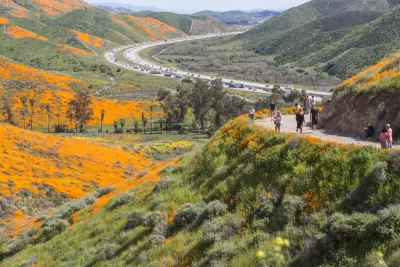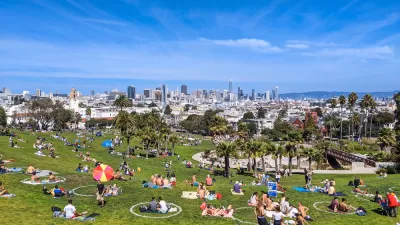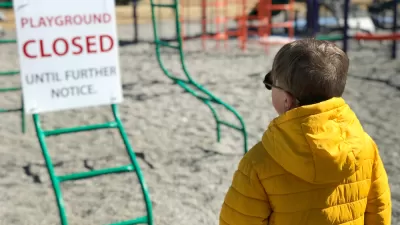One of the dominant themes to emerge from the spread of COVID-19 is the conflict between the need to be in nature for health and well-being while avoiding public space as much as possible to prevent the spread.

During and after the first weekend of stay-at-home orders in the nation's largest cities, officials scrambled to shut down parks and public open spaces after crowding quickly made social distancing guidelines impossible. Planetizen gathered the relevant news on March 24, mostly focusing on the cities taking the earliest, drastic actions to slow the spread of the coronavirus—like New York City and Los Angeles.
Since then, parks all over the country have been closed after visitors quickly overwhelmed social distancing guidelines while seeking refuge from the anxieties of the pandemic. Think pieces about what the pandemic means for the collective appreciation for parks and open space are also common.
A New Appreciation for Parks and Open Space
When the pandemic is finally over, there will be a lot of aspects of contemporary life to appreciate again, with new perspective on their value to the social and economic well being of communities. Parks and open space are a clear frontrunner for that kind of rejuvenation in the post-pandemic world.
An article by Sara Bronin for the Philadelphia Inquirer includes social and economic benefits as some of the many reasons to appreciate parks and open space, especially among the stresses of the pandemic.
Laura Bliss writes about about the need to think smaller about open space while in isolation to achieve the benefits offered by nature.
Fear and Controversy
While celebrations of the benefits of open spaces and nature have been common, so to have expressions of the new fears associated with being outside, like in a New York Times article by Jodi Kantor.
It could be possible that a lack of understanding about the seriousness of the public health crisis is evident in parks and open space, and that parks being closed is a sign of cities and communities finally coming to terms with the necessities of the crisis.
In Minneapolis on March 31, officials had to repeat directions to reduce crowding in parks—the same message sent to the city's residents earlier in the month.
Dallas Morning News Architecture Critic Mark Lamster found a bit of normalcy on the Katy Trail earlier in the crisis, for instance, but this week local officials have been threatening to shut the trail down if the same numbers of people continue to crowd the space.
In Chicago, the contest for open space continues into April. Lightfoot shut down Chicago's lakefront and other high-profile public areas on March 26. The nearby suburb of Oak Park soon followed suit. Streetsblog Chicago has upheld a protracted campaign to leverage the park closures to close public streets to automobile traffic. The lack of progress on that issue might indicate one area that public officials need to better account for the seriousness of the situation.
In a grim counterpoint to the lack of coordinated federal action in response to the epidemic, many of the nation's public parks have been shutting down since March. Yosemite shut down on March 20. Hawai'i Volcanoes shut down on March 22. Yellowstone shut down March 24. The Grand Canyon shut down on April 1. The Pacific Northwest Region of the U.S. Forest Service shut down all developed recreation sites on national forest land in both Oregon and Washington on March 30.
Perhaps most of all, however, the closure of parks and open space during the pandemic has brought a new, hypersensitive focus of the equity gaps in the use and allotments of public space in the United States, tying the controversies and challenges of the pandemic to the challenges facing cities before and after the crisis. The most vulnerable populations are less likely to have access to parks and open space. An article by Alissa Walker explores how that reality is playing out as most of the nation endures another week of isolation.
The Future of Parks and Landscape Architecture
While the debate about whether the pandemic will force a dramatic shift in urban design, and the demand for dense, urban living in cities, has dominated urbanism discussions since the beginning of stay-at-home orders and the collapse of the stock market in March.
For a change of pace on these kind of speculations about the consequences of the present for the urban design of the future, see an article by John King that explores the implications of social distancing for the field of landscape architecture [paywall], which since the days of William Whyte have been focused on enabling social connections.
Diana Budd writes on the potential of the pandemic to influence design, not just of parks, but also of the private and commercial worlds. There are plenty of examples from history of public health considerations already having achieved dramatic influence on design practice.
On a similar theme, words from Curbed design critic Alexandra Lange are buried in this Politico roundtable of experts predicting the post-pandemic future. Lange's prediction: "Society might come out of the pandemic valuing these big spaces even more, not only as the backdrop to major events and active uses, but as an opportunity to be together visually."

Planetizen Federal Action Tracker
A weekly monitor of how Trump’s orders and actions are impacting planners and planning in America.

Restaurant Patios Were a Pandemic Win — Why Were They so Hard to Keep?
Social distancing requirements and changes in travel patterns prompted cities to pilot new uses for street and sidewalk space. Then it got complicated.

Map: Where Senate Republicans Want to Sell Your Public Lands
For public land advocates, the Senate Republicans’ proposal to sell millions of acres of public land in the West is “the biggest fight of their careers.”

Maui's Vacation Rental Debate Turns Ugly
Verbal attacks, misinformation campaigns and fistfights plague a high-stakes debate to convert thousands of vacation rentals into long-term housing.

San Francisco Suspends Traffic Calming Amidst Record Deaths
Citing “a challenging fiscal landscape,” the city will cease the program on the heels of 42 traffic deaths, including 24 pedestrians.

California Homeless Arrests, Citations Spike After Ruling
An investigation reveals that anti-homeless actions increased up to 500% after Grants Pass v. Johnson — even in cities claiming no policy change.
Urban Design for Planners 1: Software Tools
This six-course series explores essential urban design concepts using open source software and equips planners with the tools they need to participate fully in the urban design process.
Planning for Universal Design
Learn the tools for implementing Universal Design in planning regulations.
Heyer Gruel & Associates PA
JM Goldson LLC
Custer County Colorado
City of Camden Redevelopment Agency
City of Astoria
Transportation Research & Education Center (TREC) at Portland State University
Camden Redevelopment Agency
City of Claremont
Municipality of Princeton (NJ)





























